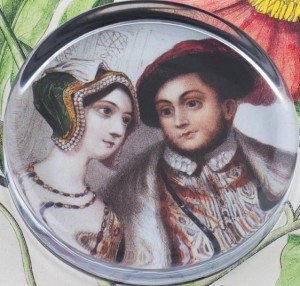 On this day in history, 26th August 1533, the ceremony of the Queen’s “taking her chamber” took place at Greenwich Palace.
On this day in history, 26th August 1533, the ceremony of the Queen’s “taking her chamber” took place at Greenwich Palace.
A heavily pregnant Queen Anne Boleyn attended a special mass at the Chapel Royal of Greenwich Palace and then processed, with her ladies, to the Queen’s great chamber.
There, the group enjoyed wine and spices before Anne’s lord chamberlain prayed that God would give the Queen a safe delivery. After the prayer, Anne and her ladies retired to her chamber, which, from that moment on, would be a male-free zone.
In his book “Elizabeth”, David Starkey describes how Anne Boleyn’s chamber would have been prepared for the impending birth:-
“The walls and ceilings were close hung and tented with arras – that is, precious tapestry woven with gold or silver threads – and the floor thickly laid with rich carpets. The arras was left loose at a single window, so that the Queen could order a little light and air to be admitted, though this was generally felt inadvisable. Precautions were taken, too, about the design of the hangings. Figurative tapestry, with human or animal images was ruled out. The fear was that it could trigger fantasies in the Queen’s mind which might lead to the child being deformed. Instead, simple, repetitive patterns were preferred. The Queen’s richly hung and canopied bed was to match or be en suite with the hangings, as was the pallet or day-bed which stood at its foot. And it was on the pallet, almost certainly that the birth took place.
Carpenters and joiners had first prepared the skeleton by framing up a false ceiling in the chamber. Then the officers of the wardrobe had moved in to nail up and arrange the tapestry, carpets and hangings. At the last minute, gold and silver plate had been brought from the Jewel House. There were cups and bowls to stand on the cupboard and crucifixes, candlesticks and images for the altar. The result was a cross between a chapel and a luxuriously padded cell.”1
David Starkey describes this ritual confinement as “a sort of purdah” and writes of how it “emphasized that childbirth was a purely female mystery.”
The birthing chamber, which sounds as if it would have been rather stifling in a hot August, was to be Anne Boleyn’s home until she was churched thirty days after the birth. Fortunately for Anne, her baby came sooner than expected and she gave birth to a girl, the future Elizabeth I, on the 7th September 1533.
This must have been a very special and exciting time for Henry VIII and Anne Boleyn as they anticipated the birth of their first child together, a child who was expected to be male and who would be the next king. Henry was convinced that God would bless this marriage and He did, for the resulting child, Elizabeth I, was one of the finest monarchs England has ever had.
Trivia: Greenwich Palace was where Elizabeth of York had given birth to Henry VIII.
Notes and Sources
- Elizabeth, David Starkey, p2-3